SHARES
| FacebookTwitter |
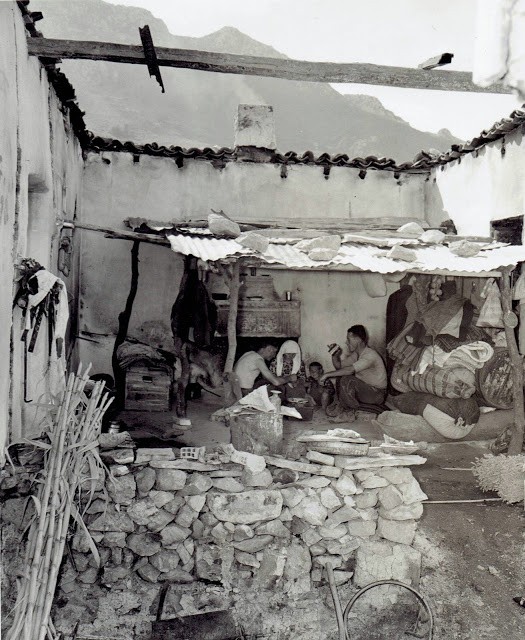
Despite the fact that several historians and modern day Nazi apologists are trying to exonerate the Germans for the countless atrocities and crimes against humanity they committed in Greece during WW2, the truth cannot be hidden.
In Greece, from 1941 to 1944, the civilian deaths resulting from the Nazi German, fascist Italian (until 1943, when the Italians swiftly changed sides) and Bulgarian occupation, adds up to about 578,000 persons.
That number comprises the deaths resulting from the persistent famine caused by the economic policies of the Axis, and the violent deaths resulting from the resistance and the reprisals.
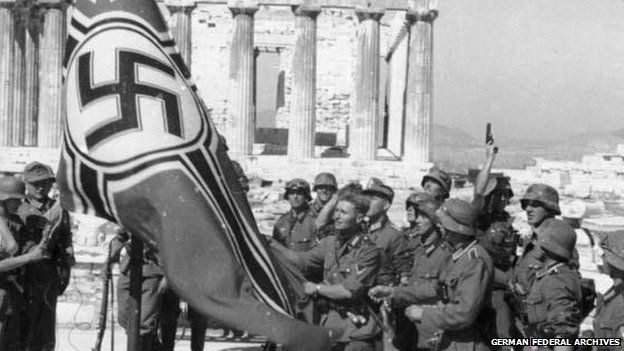
It does not include though the deaths resulting from diseases such as TB and malaria, persistent malnutrition, wounds and exposure, which are a direct result of war conditions, but which occurred shortly after the end of the war.
It is estimated that the overall loss of life due to the war to be 13% of the Greek population.
In August 1944, Greek guerrilla fighters attacked the German military camp at Vrastamites (the village is called today “Ypsilandis”, in Boeotia, central Greece).
The Germans burned down every house in the village and dynamited the church in retaliation.
All able-bodied men who could be caught were shot, and the rest fled for their lives to the mountains.
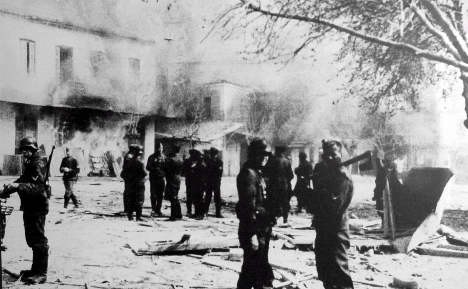

The Greeks were the first Europeans who won a victory against fascism. They defeated the Italian allies of the Germans. They fought bravely against the attacking Germans and kept fighting them throughout the occupation of their country, 1941-1944.
Once in Greece, the GermansREWARDED Greek bravery with implacable hostility. They dismembered the country, dividing it between the Bulgarians, the avenging Italians, and themselves.
Greek bravery with implacable hostility. They dismembered the country, dividing it between the Bulgarians, the avenging Italians, and themselves.
 Greek bravery with implacable hostility. They dismembered the country, dividing it between the Bulgarians, the avenging Italians, and themselves.
Greek bravery with implacable hostility. They dismembered the country, dividing it between the Bulgarians, the avenging Italians, and themselves.
The unspoken strategy of the occupiers (Germans, Italians, Bulgarians) was to wipe out the Greeks through starvation, bombing, and mass murder.
They did that, inflicting unspeakable atrocities against the civilian population. But the Germans, being the warlords-in-chief, outdistanced their partners in crime, Bulgarians and Italians. Their barbarism easily surpassed that of all previous foreign occupiers of Greece.
In the short period of German occupation, 1941-1944, the violence of the German-led armies of conquest turned Greece from a modestly well-to-do country to a country on the brink of death.
The following math of mass starvation and murder tell the story. The numbers come from “The Sacrifices of Greece in the Second World War,” a 1946 report prepared for the Greek government by the architect K. A. Doxiadis.
The story of WWII Greece starts with food, the weapon of starvation for the occupiers. During 1941-1944, there was a dramatic decline in Greek food production: wheat and barley, life and death crops for the Greeks, dropped by 40 percent; beans, 36 percent; tobacco, 89 percent; cotton, 75 percent; olive oil, 16 percent; grapes and raisins, 66 percent; wine, 50 percent; fruits, 20 percent.
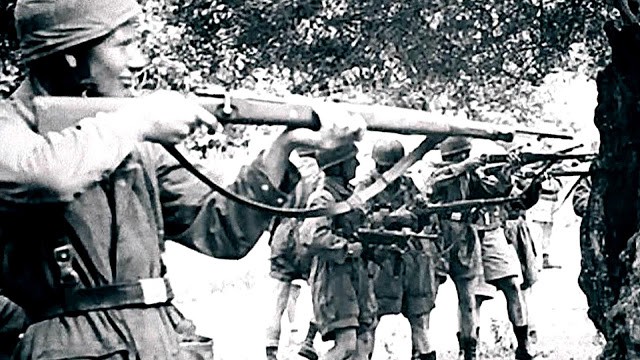
The occupiers speeded Greek starvation by killing the peasants’ farm animals. They slaughtered 60 percent of the horses, mules, and cattle; 50 percent of the donkeys, sheep and goats; 80 percent of the hogs; and 50 percent of the chickens.
Next after food, the entire country became a field of desolation for the Germans, Italians and Bulgarians. They destroyed 25 percent of the country’s forests; 56 percent of the roads; 50 to 90 percent of the bridges; 65 percent of automobiles; 60 percent of the trucks; 80 percent of the buses; 100 percent of the trains and railways; 80 percent of the factories; 100 percent of the water and sewage infrastructure.
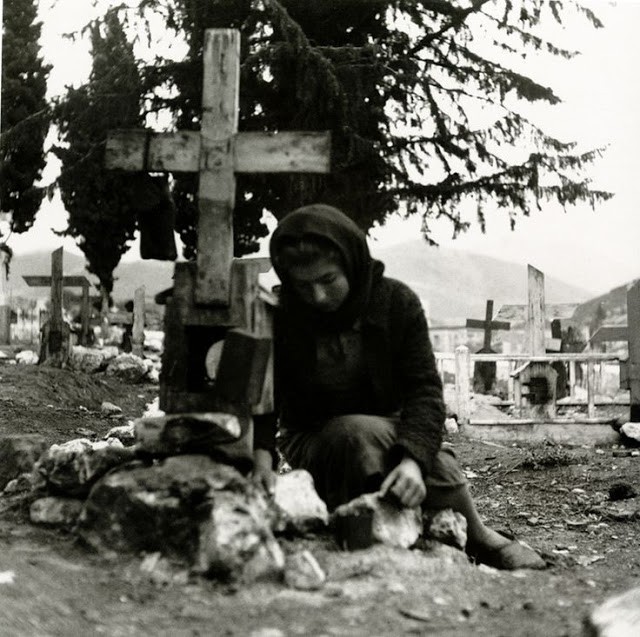
The 1946 report says: “principal harbors were blown up…INSTALLATIONS , machinery and quays were destroyed.” The Germans also blew up the strategic Corinth canal. In addition, the Germans sank 74 percent of the Greek ships and destroyed 100 percent of telephone communications.
, machinery and quays were destroyed.” The Germans also blew up the strategic Corinth canal. In addition, the Germans sank 74 percent of the Greek ships and destroyed 100 percent of telephone communications.
 , machinery and quays were destroyed.” The Germans also blew up the strategic Corinth canal. In addition, the Germans sank 74 percent of the Greek ships and destroyed 100 percent of telephone communications.
, machinery and quays were destroyed.” The Germans also blew up the strategic Corinth canal. In addition, the Germans sank 74 percent of the Greek ships and destroyed 100 percent of telephone communications.
The Germans bombed all major Greek cities, inflicting heavy damage. According to the 1946 study: “The whole country lies in ruins. From northern Epirus to the Dodecanese large and small buildings, churches, schools, hospitals and dwellings have been transformed into a mass of tragic ruins.”
The countryside had a similar fate. According to the 1946 study, “the occupying forces applied a systematic plan for the destruction of Hellenism: the burning of villages. 1,770 Greek villages lie in ashes. In certain parts of the country, particularly near the frontiers, destruction by fire reached the proportion of 90 % of the villages of everyREGION .”
.”
 .”
.”
The Germans and their allies killed or were responsible for the death of thirteen percent of the Greek population. In 1940, there were 7,335,000 people in Greece. In 1944, the population numbered 6,805,000 persons. The report notes that the favorable methods of mass murder included: “Hangings, massacres, shootings, [and] death vans.”
The genocidal effects of German occupation of Greece reached a macabre climax in June 1944. On June 10, 1944, Greek partisans killed a few German soldiers near Distomo, a small village near Parnassus and Delphi. The Germans retaliated with crusading ferocity.
Hundreds of soldiers advanced toward Distomo – spreading death on their way, shooting people and animals. Once in the village, the Germans acted with a mania for death and criminality rarely matched in history. They kept shooting anyone on sight. But eventually, they put the annihilation of Distomo into action. They raped all female children and women, cutting their breasts and ripping apart their stomachs. In some cases, they strangled the women with their own guts.
They cut the throats of all infants.
The Germans then shot or hanged all boys and men.
In fact, they used bayonets to crucify men on trees lining the streets. All this mayhem took the Germans an entire day. The next day, they came back to Distomo and filled their trucks with looted goods from the homes of the dead peasants.
A Swedish Red Cross worker stationed in Athens, Sture Linner, witnessed the results of the German atrocity. In his book, My Odyssey, he admits he drove a truck full of food to Distomo. It was June 14, 1944. He entered a village in flames, empty of life, utterly destroyed. The picture could have matched Dante’s inferno.
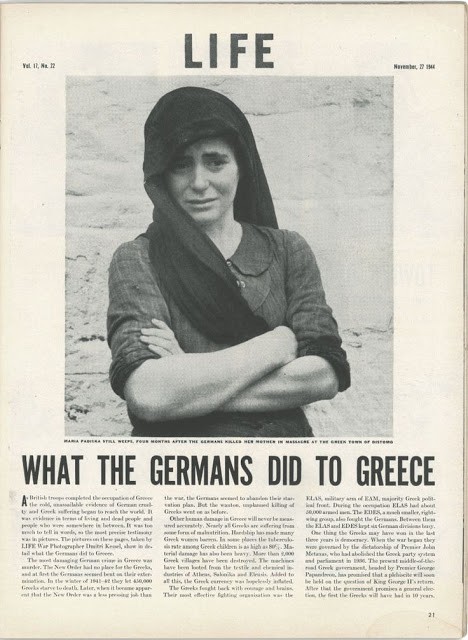
Linner visited Distomo in November 1944 when the Germans were withdrawing from Greece. Greek partisans surrounded a detachment of German soldiers near Distomo. Linner drove a truck full of food. A priest and a Greek military commander met him near the village. The priest said both Greeks and Germans were starving. But he urged Linner to feed the defeated Germans because they had a long way to reach home.
Linner’s Greek wife burst into tears.
Two executive orders issued at the highest levels of the Third Reich played an important role in the Greek Holocaust.
The first, issued by Hitler himself, was the torching directive according to which, if there was a suspicion that a residence was used by the resistance, that building was a legitimate target for burning, regardless of the possibility that the majority of the inhabitants might be non-combatants.
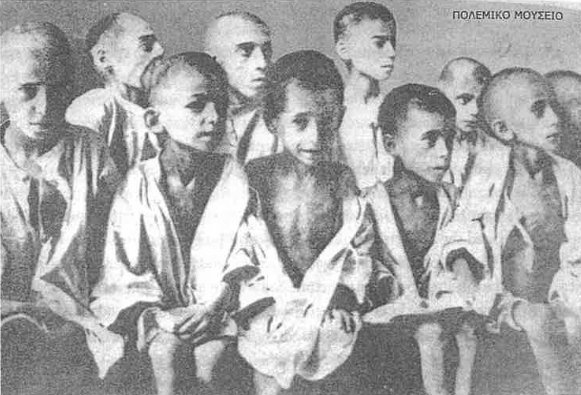
The second order, signed by Marshal Wilhelm Keitel on 16 September 1941, specified that for every German killed, a minimum of 100 hostages would be executed, and for every wounded one, 50 would die.
The first mass executions took place in Crete even before the island fell to the Germans.
In 1945, under the auspices of the United Nations, a 4-member committee headed by Nikos Kazantzakis was given the task to investigate Axis atrocities in Crete. The Kazantzakis report enumerates the destruction of more than 106 Cretan villages and many massacres.
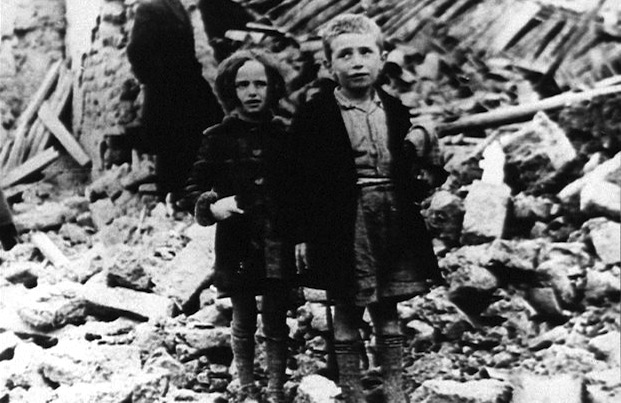
The area around the Agias Prison in the Hania area was found hiding several mass graves. The first mass murder was recorded in the village Galatas, near Hania, where the villagers had dared defend their birthplace from the invading Germans.
On 26 May 1941, while the battle was still raging, the Germans murdered old men and women in their homes, and looted and burned the village. One of the massacres the Kazantzakis committee did not report was the murder of all men in Kontomari.
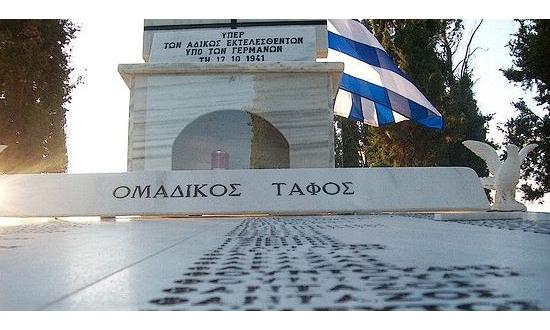
That massacre was immortalized for posterity by Peter Weixler, a German officer whose photographs graphically describe the execution.
An even worse fate befell the village Kandanos, whose men and women had fought the Germans in order to allow hundreds of Allied troops to escape the paratroopers by reaching safely the south shore of Crete.
In Kandanos all men and women were murdered. Among those executed was Kostas Archakis, aged 103 and two 80-year old women who were thrown into their burning homes to endure horrible deaths.
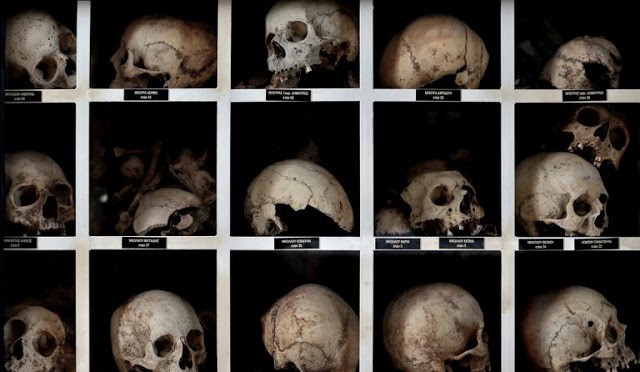
These massacres were only the beginning. On 20 October 1941 in Ano and Kato Kerdyllia in Macedonia, the Germans gathered 222 men ages 15 to 60, ordered them to excavate a mass tomb, executed them under the gaze of their families, and then burned the villages.
On 24 October, in Mesovouno of Ptolemais, they executed 165 men and then burned the village. On 25 October, in the area of Kilkis, they executed 96 men and then burned the villages Kleisto, Kydonia and Ampelofyto.
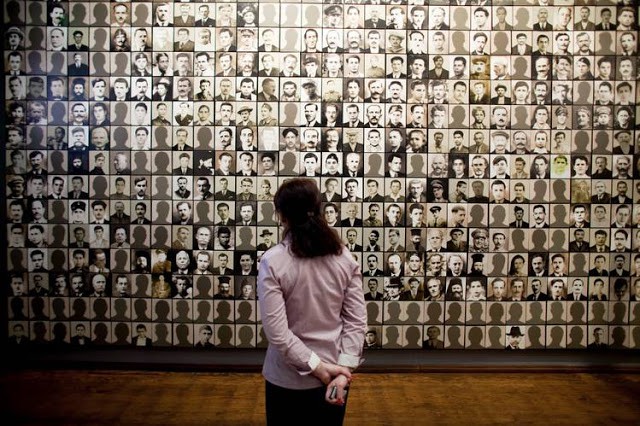
Those massacres were carried out solely in order to intimidate the population. The massacres continued through 1942 and intensified in 1943, when the Greek Resistance, obeying orders from the Middle East Allied Headquarters, intensified their activities against the occupation forces.
That was part of the Allied strategy, aimed to convince the Germans that a landing on the Greek shores was forthcoming, whereas their plan was to land on Sicily. On 26 July 1943 the Germans massacred 154 people in Mousiotitsa of Epirus and burned the village.
On August 16, the day after one of the greatest holy days of the Eastern Orthodox church, the Dormition of the Mother of Jesus, the Germans, also in Epirus, destroyed the village Kommeno.
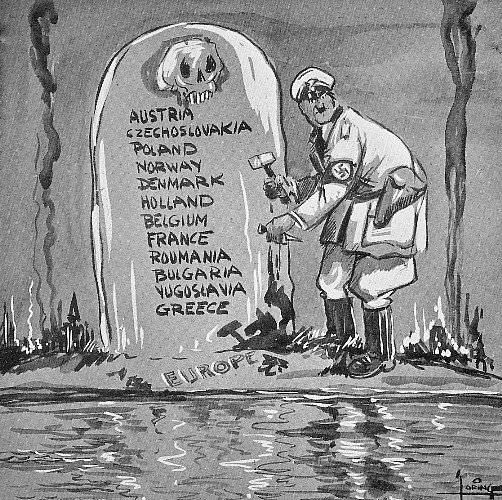
There had been no incident to incite that massacre. Only a suspicion that there were guerrillas in its vicinity.
This particular massacre has been studied by historians in some detail, because there were survivors who managed to escape by swimming the fast waters of Arahthos river, or by hiding in the forested area bordering the village. In Kommeno, the Germans murdered 145 men, 174 women and 97 children, 414 in all.
Twenty families were wiped out completely and 17 people drowned trying to cross Arahthos.
Kurt Waldheim, who reported that massacre to Berlin from his position in Thessaloniki, reported only the 145 men who were killed, neglecting to mention women and children, and falsified facts by citing explosions of large quantities of munitions, which never took place. Eventually Kurt Waldheim became Secretary General of the United Nations and President of Austria.
More than 90 holocausts have taken place in Greece, in which the majority of the inhabitants were murdered. In addition, 1,700 to 1,800 villages were burned, many of them totally.

The Germans developed the act of destruction to the level of a fine art: they spread the condemned structures with incendiary powders, which under fire from a gun or a pistol exploded into flames.
They also developed the military vocabulary to match their unparalleled ingenuity of destruction: the elimination of a population, as in Kommeno, was a Clean-Up Operation Undertaking: Waldheim talks about Sauberungsunternrhmen (Purging Operation) Kommeno , for example.
The troops charged to carry out the systematic looting of Greek households and farms were the Aufraumtruppen (Clean-Up Troops). The stealing of Greek property was carried out under orders by the highest command of the Wehrmacht.
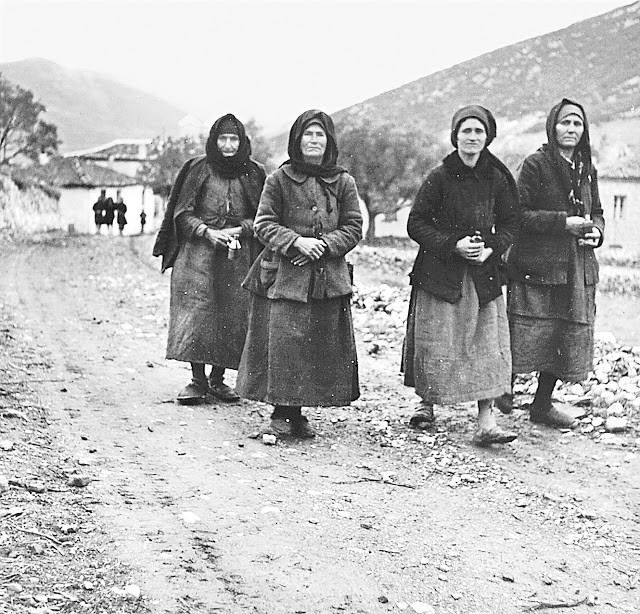
The story of the Greek Holocaust would not be complete without mentioning Kalavryta, Distomo, Hortiati and Agios Georgios.
In Kalavryta, 1,100 men 12 to 90 years old were executed on a gently sloping corn field outside the town, while the women and young children of the village were held in the school house, which was set afire.
The women broke the doors and escaped death, but the male population was killed in the largest one-day atrocity in a non-Slavic land.
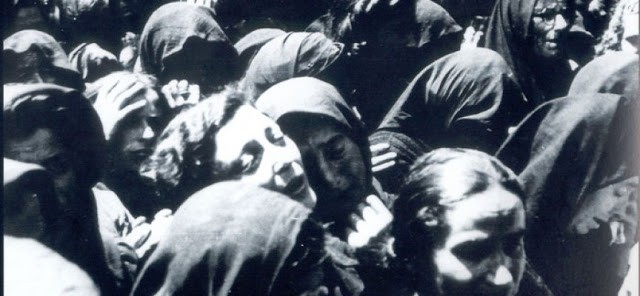
The date was 13 December 1943. That massacre took place as a revenge for the killing of German prisoners of war by the ELAS andartes (guerillas). But the Kalavrytans were not responsible for that act, and in fact they had tried hard to safeguard the German prisoners that the guerillas kept in their city.
All the villages in the vicinity of Kalavryta were destroyed, and their inhabitants were murdered. The monks at the nearby Mega Spilaio historic monastery, as well as the monks in Agia Lavra, where the Greek revolution of 1821 was first declared, were also murdered. The Germans killed everyone they run across as they moved from one village to the other.

The historical Archives at the Ministry of Foreign Affairs in Athens are replete with accounts of massacres perpetrated throughout Greece. Atrocities in which the eager German troops exceeded the directive of 100 Greeks killed per German death abound.
On 2 September 1944, at the village Hortiati, 20 kilometers east of Thessaloniki, the Germans executed 149 civilians of both sexes and all ages for the death of one German who was killed in a skirmish with ELAS. On 15 June, 1944, two German soldiers were wounded in a battle with ELAS near the village Ayios Georgios on the road from Levadia to Thebes.

After the andartes (guerillas) left, the Germans rounded up 26 men women and children from that village, ushered the men into a small house and killed them with machine gun fire while the women, older men and children watched. Then they executed the rest of the group, threw their corpses in the same small house, doused them all with gasoline and set them afire. An infant who had survived was thrown into the pyre alive.
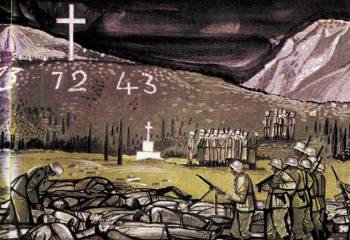
The massacre that took place on 10 June 1944 in Distomo surpasses in sadism virtually all massacres. On that day, the Germans gathered the residents of Distomo in the school building and slaughtered them in the most horrific ways.

Two hundred and thirty two men women and children were tortured and killed in ways which we shall not detail here, out of respect for the reader.
By Pierre Kosmidis / pierrekosmidis.blogspot.gr

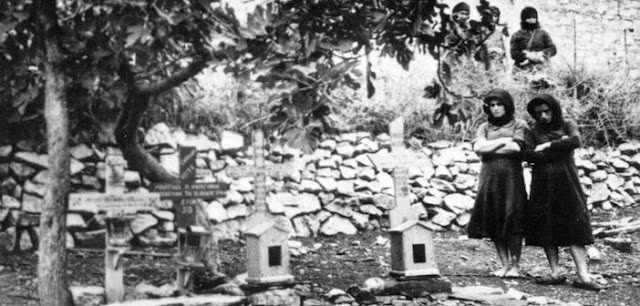
Δεν υπάρχουν σχόλια:
Δημοσίευση σχολίου